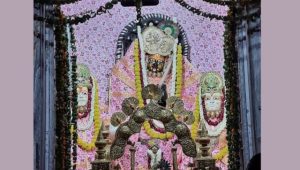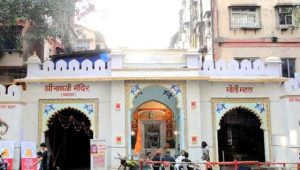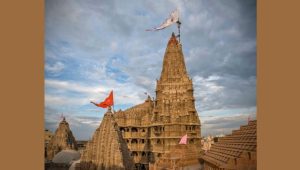Krishna Janmashtami, the birth of Lord Krishna, will be celebrated this year on 6 and 7 September. The festival which is also known as Gokulashtami or Janmashtami is celebrated by the Hindu community with great fervour and enthusiasm. As per Drik Panchang, this year marks the 5250 birth anniversary of Lord Krishna. Krishna Janmashtami 2023: Date and Time Krishna Janmashtami date: 6 September, 2023 (Wednesday) Nishita Puja time: 11:57 pm to 12:42 am, 7 September, 2023 (Thursday) Dahi Handi date: 7 September, 2023 If you are a true bhakt or devotee and wish to celebrate Janmashtami at a religious place that has history Krishna then you should visit these temples: Krishna Janmabhoomi, Mathura [caption id=“attachment_13076972” align=“alignnone” width=“300”] Krishna Janmasthan, Mathura. Source mathuravrindavantourism.co.in[/caption] As per mythology, Krishna Janmabhoomi in Mathura, Uttar Pradesh is considered to be the birthplace of Lord Krishna. This place is considered as a pilgrimage spot and is said to have been built around the prison cell where Lord Krishna was born. The temples that we see there today are the result of a major refurbishment that took place in the 20th century. It comprises of Keshavdeva Temple, with the garbha griha (sanctum sanctorum) located at what is said to be the birthplace of Lord Krishna, and the Bhagavata Bhavan. As per legend, parents of Lord Krishna - Vasudeva and Devaki were imprisoned by Kansa, the king of Mathura at this place. He imprisoned them due to a prophecy which stated that the king will be killed by his sister’s child. During Janmashtami, the temple is decked up and lakhs of devotees throng there. Celebrations begin during mid-night with the birth of Lord Krishna. Banke Bihari temple, Vrindavan
Not far from Mathura, the neighbouring city Vridavan also wears a different look on Krishna Janmashtami. Vrindavan is situated on the bank of sacred Yamuna river and as per mythology, Lord Krishna was spent his childhood days here. In Vrindavan, Banke Bihari temple holds special events for Krishna Janmashtami. The idol of Bihariji installed in the temple is the one granted to Swami Haridas by the celestial couple Shyama-Shyam themselves. As per the temple trust, submitting to the desire of devotees the Lord appeared in person with his divine consort and left back a black charming image before disappearing. Nidhivan [caption id=“attachment_13077022” align=“alignnone” width=“300”] Nidhivan. Source: bihariji.org[/caption] Another famous place is Nidhivan, a sacred forest in Vrindavan, is a place surrounded by legends. Also known as the Forest of Tulsi, Nidhivan is a place where basil ’trees’ are in pairs and are believed to be gopis, who come to life at night. It is believed that every night, at Nidhivan, Lord Krishna and Radha perform raasleela and all the trees in the vicinity are believed to turn into gopis (female cowherds who were devoted to Krishna). Also, each evening after sunset, a bed is laid for Lord Krishna and Radha, along with some food, water, ornaments, clothes and neem twigs. It is said that every morning these things appear to have been used. Nobody is allowed to stay in the premises after sunset inside Nidhivan. Gokul Temple [caption id=“attachment_13077042” align=“alignnone” width=“300”]
 Gokul temple. Source: ebnw.net[/caption] Situated 16 kms from Mathura city, Gokul temple is the birth place of Lord Krishna. It is believed that when Lord Krishna was infant, he was brought up in secrecy in the home of his foster mother Yashoda. It is said that Vasudeva, father of Lord Krishna secretly exchanged his son with the infant daughter of Nanda and Yashoda in order to save him from the hand of Kansa. Lord Krishna spent his childhood and adolescence in Gokul only. During his stay at Gokul, Krishna spent his time with full enjoyment though he his life did come under threat a few times. At Gokul temple too, Krishna Janmashtami is celebrated with pomp and fervour. Shrinathji Temple [caption id=“attachment_13077082” align=“alignnone” width=“300”]
Gokul temple. Source: ebnw.net[/caption] Situated 16 kms from Mathura city, Gokul temple is the birth place of Lord Krishna. It is believed that when Lord Krishna was infant, he was brought up in secrecy in the home of his foster mother Yashoda. It is said that Vasudeva, father of Lord Krishna secretly exchanged his son with the infant daughter of Nanda and Yashoda in order to save him from the hand of Kansa. Lord Krishna spent his childhood and adolescence in Gokul only. During his stay at Gokul, Krishna spent his time with full enjoyment though he his life did come under threat a few times. At Gokul temple too, Krishna Janmashtami is celebrated with pomp and fervour. Shrinathji Temple [caption id=“attachment_13077082” align=“alignnone” width=“300”] Shrinathji Temple Udaipur. Source: udaipurtourism.co.in[/caption] Across Rajasthan, Krishna Janmashthami is celebrated with utmost enthusiasm, but at Shrinathji temple, located in the city of Nathdwara the festival sees massive footfall of devotees. The divine form of Shrinathji is said to be Swayambhu (self-manifested) and symbolises Krishna in child-form. In the temple, the image of Shrinathji is made from a single slab of black marble which portrays Krishna as lifting the Govardhan hill with one arm raised. The Lord is depicted with his left hand raised and the right hand at the waist, along with a large diamond placed beneath his lips. The temple today is a much sought-after pilgrim and tourist center, attracting visitors from all over the world. Dwarkadhish Temple [caption id=“attachment_13077102” align=“alignnone” width=“300”]
Shrinathji Temple Udaipur. Source: udaipurtourism.co.in[/caption] Across Rajasthan, Krishna Janmashthami is celebrated with utmost enthusiasm, but at Shrinathji temple, located in the city of Nathdwara the festival sees massive footfall of devotees. The divine form of Shrinathji is said to be Swayambhu (self-manifested) and symbolises Krishna in child-form. In the temple, the image of Shrinathji is made from a single slab of black marble which portrays Krishna as lifting the Govardhan hill with one arm raised. The Lord is depicted with his left hand raised and the right hand at the waist, along with a large diamond placed beneath his lips. The temple today is a much sought-after pilgrim and tourist center, attracting visitors from all over the world. Dwarkadhish Temple [caption id=“attachment_13077102” align=“alignnone” width=“300”] Dwarkadhish Temple. Source: gujarattourism.com[/caption] Situated in Gujarat, Dwarka, the Dwarkadhish Temple is believed to have been established more than 2500 years ago by Lord Krishna’s great grandson, Vajranabh. The temple stands on a small hill that has to be ascend by more than 50 steps, with heavily sculptured walls that cocoon the sanctum with the main Krishna idol. Around the complex lie other smaller shrines. At Dwarkadish temple too, devotees throng in large number to participate Krishna Janmashthami celebrations. ISKCON Temple [caption id=“attachment_13077122” align=“alignnone” width=“300”]
Dwarkadhish Temple. Source: gujarattourism.com[/caption] Situated in Gujarat, Dwarka, the Dwarkadhish Temple is believed to have been established more than 2500 years ago by Lord Krishna’s great grandson, Vajranabh. The temple stands on a small hill that has to be ascend by more than 50 steps, with heavily sculptured walls that cocoon the sanctum with the main Krishna idol. Around the complex lie other smaller shrines. At Dwarkadish temple too, devotees throng in large number to participate Krishna Janmashthami celebrations. ISKCON Temple [caption id=“attachment_13077122” align=“alignnone” width=“300”] Source: Pexels[/caption] The International Society for Krishna Consciousness, or ISKCON, that has branches in most parts of India and world also celebrates Krishna Janmashtami with vigour. Hari kirtans, dance performaces, skits are performed. There is also special bhog on Janmashtami in all ISKCON temples. On Janmashtami, devotees engage in ‘Dahi Handi’ events, where young men form human pyramids to break a clay pot filled with butter or curd, replicating the childhood antics of Lord Krishna.
Source: Pexels[/caption] The International Society for Krishna Consciousness, or ISKCON, that has branches in most parts of India and world also celebrates Krishna Janmashtami with vigour. Hari kirtans, dance performaces, skits are performed. There is also special bhog on Janmashtami in all ISKCON temples. On Janmashtami, devotees engage in ‘Dahi Handi’ events, where young men form human pyramids to break a clay pot filled with butter or curd, replicating the childhood antics of Lord Krishna.


)

)
)
)
)
)
)
)
)



